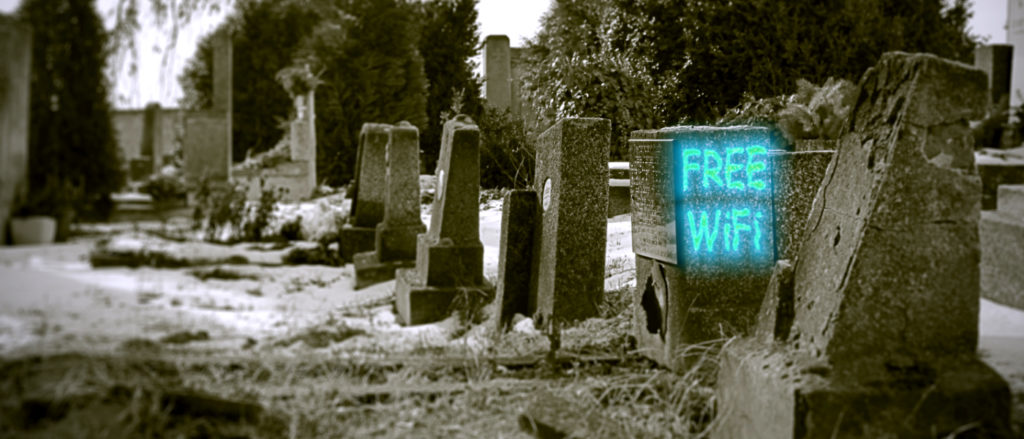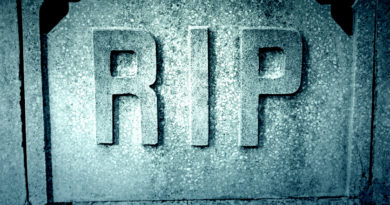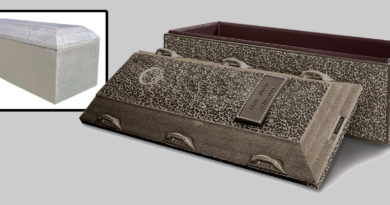Cemetery Headstones Go High-tech

Because of computer microchips and sophisticated electronics and software, nearly everything we interact with these days offers some form of technology intended to make our lives easier. From gizmos that tell those cursed with brown thumbs when their plants need water to fridge magnets that let you order pizza just by tapping them, the application of technology to everyday items knows no limit.
Recently, even the humble headstone has received its share of innovation thanks to modern technology. Today, three technologies hope to transform cemetery gravemarkers from mere slabs of stone into sophisticated storytelling devices that provide “electronic epitaphs” in order to help survivors share the unique life story of their loved one.
QR Codes
A quick-response code (QRC) is similar to the ubiquitous universal product code (UPC) found on the packaged food we purchase in grocery stores. Unlike a UPC, however, which only functions in one dimension (horizontally), a QRC functions in two dimensions (horizontally and vertically). This greater data capacity enables QRCs to convey alphanumeric information, such as email addresses, website addresses, telephone numbers, text messages, contact information, etc.
Because of this ability, several companies now offer QRC medallions specifically created for cemetery gravemarkers. Generally, each unique QRC is laser-etched onto a metal plaque, such as stainless steel or bronze, and then affixed to the headstone using a heavy-duty, outdoor-quality adhesive.
When a visitor to the gravesite scans the medallion using an app designed to read QRCs on an iPhone, iPad or similar smart device, the scanned link takes the user to a memorial website created by the deceased’s loved ones. These sites can offer text, photos, a guestbook for visitors to sign, and even links to social-media sites, such as Facebook and Twitter, so users can share the QRC link with others or visit additional memorial pages about the deceased.
One advantage that QRCs possess versus other technologies is that the decision to add a QRC medallion need not be made right away. In other words, surviving loved ones can decide to add a QRC to a headstone at any time, even years after the death occurred.
Video Screens
We take for granted these days our ability to access movies, games, flight information, advertisements, etc., courtesy of our smart devices, but imagine discovering a similar LCD video screen affixed to, or embedded within, a cemetery headstone. If you’ve seen or used an informational kiosk at a grocery store or an airport, you’ll understand the concept here.
Unlike the QRC medallion described above, gravestone video screens do not require visitors to access the enhanced information available about the deceased via an external device, such as a smartphone or tablet computer. Instead, visitors simply press a button on the LCD screen to trigger a short memorial video prepared by surviving loved ones. Powered by solar-energy panels, these “talking tombstones” are generally weather- and shatter-resistant for longevity and to minimize vandalism.
NFC Microchips
Similar in operation to the QRC plaque described above, a near-field communication (NFC) headstone sports a special medallion that utilizes short-range wireless connectivity that many current smartphones can access without downloading and installing a special software application, provided that device is NFC-aware. (Some monument providers can also embed the NFC chip within the headstone.)
When a visitor places his or her smart device close to a NFC-enabled gravemarker, or even touches it to the headstone, the device will display a photograph and information about the deceased prepared by his or her loved ones. And even if the user’s smart device is not NFC-aware, he or she can still input the unique URL shown on the NFC medallion in order to discover more about the life of the deceased. To see if your smart device is NFC-aware, check out this list of current NFC-enabled smart devices.
Author’s Note: While advances in technology have enabled gravemarkers to communicate much more about the person who died than the usual name and dates found on traditional headstones, the high-tech enhancements above have yet to catch on with the public. Thus, you might have difficulty finding a supplier of QRC, video screen or NFC technologies for gravemarkers right now.







